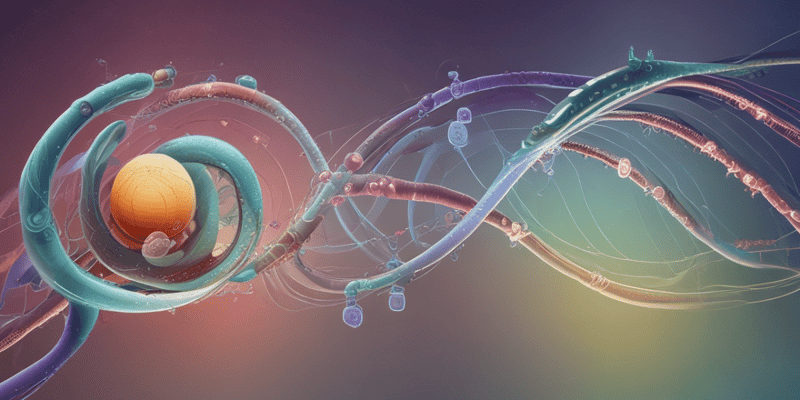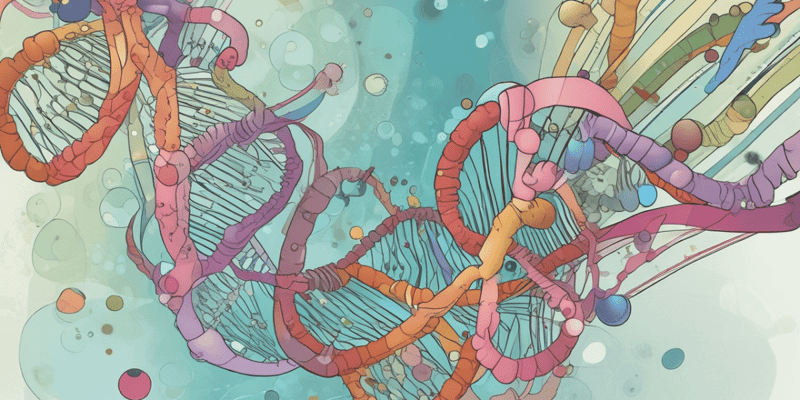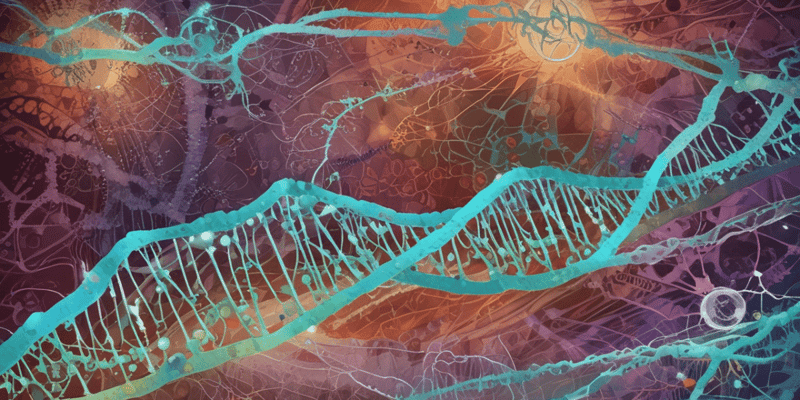30 Questions
What is the first stage of gene expression?
Transcription
What is the role of RNA polymerase in gene expression?
To synthesize RNA molecules
What type of RNA is used as a template for protein synthesis?
mRNA
What happens during the transcription process?
The DNA sequence is transcribed to RNA molecule
What is the indirect process by which genes encode proteins?
Gene → mRNA → Protein
What is the function of transfer RNA (tRNA)?
To function in translation of mRNA to protein
What is the term for the process of converting the information carried by DNA molecule into protein molecules?
Gene expression
Which subunit of RNA polymerase is necessary for binding to specific DNA sequences?
σ subunit
What is the function of the core RNA polymerase?
To catalyze the polymerization of NTPs into RNA polymers
What is the consensus sequence found at the -10 region of the promoter?
TATAAT
What is the effect of mutations in the -10 and -35 consensus sequences?
A strong effect on promoter function
What is the first step in the initiation of transcription?
Binding of the σ subunit to the promoter regions
What is the function of the σ subunit in the initiation of transcription?
To bind to the -35 and -10 promoter regions
What is the direction of RNA synthesis catalyzed by RNA Polymerase?
5' → 3'
What is the function of the sigma (σ) subunit in prokaryotic RNA Polymerase?
To recognize promoter sequences on DNA
What is the region of the DNA double helix that is unwound during the initiation of transcription?
-12 to +2
What is the role of divalent metal ions in transcription?
To activate RNA polymerases
What type of RNA synthesis occurs in prokaryotic organisms?
mRNA, tRNA and rRNA synthesis
What is the function of small RNAs?
To regulate gene expression
What is required for transcription to occur?
DNA template, RNA polymerases, Ribonucleoside triphosphates and divalent metal ions
What is the model organism for transcription studies?
E. coli
What is the result of RNA polymerase unwinding DNA around the initiation site?
Formation of single-stranded DNA
What is the role of σ in E. coli transcription?
To bind to promoter regions
What is the minimum length of the RNA molecule when σ is separated?
10 nucleotides
What is the function of RNA polymerase during elongation?
To unwind DNA ahead and rewind DNA behind
What is the region of transcription maintained by RNA polymerase during elongation?
15 base pairs
What is the function of the internal channel between the β and β' subunits of RNA polymerase?
To form the active site of the polymerase
What is the result of RNA polymerase encountering the termination signal?
Transcription stops
What is the function of the template DNA during elongation?
To remain associated with the polymerase
What is the second step of E. coli transcription?
Opening and unwinding of a small portion of DNA double helix
Study Notes
Gene Expression
- Gene expression is the process of converting DNA information into protein molecules
- Gene expression occurs in two steps: transcription and translation
- Transcription is the process of making an RNA copy of a gene sequence
- Translation is the process of translating the nucleotide sequence of an mRNA molecule to the amino acid sequence of a protein
Transcription
- Transcription is the first stage of gene expression
- In eukaryotic cells, transcription of mRNA involves:
- Synthesis of RNA molecules (formation of the first transcript, pre-mRNA)
- RNA processing/modifications (intron splicing, end modifications) to form mature mRNA
- RNA synthesis requires enzymes called RNA polymerases
- RNA polymerase was first discovered by J.Hurwitz and S.Weissman in 1960
RNA Types
- Messenger RNA (mRNA): used as a template for protein synthesis
- Ribosomal RNAs (rRNA):
- Transfer RNA (tRNA): functions in translation of mRNA to protein
- Small RNAs: function in mRNA splicing, rRNA processing, and regulation of gene expression
Transcription Requirements
- DNA template
- RNA polymerase
- Ribonucleoside triphosphates (ATP, GTP, CTP, UTP)
- Divalent metal ions (Magnesium (Mg+2) or Mn+2)
Stages of RNA Synthesis
- Binding of RNA polymerase to promoter sequences of DNA template
- Initiation of RNA synthesis
- Elongation of polynucleotide chain
- Termination of synthesis
Prokaryotic Transcription
- E. coli is a model organism for transcription studies
- mRNA was first discovered in E. coli
- RNA polymerase was purified from E. coli
- Mechanisms that regulate gene expression were discovered in E. coli
RNA Polymerase
- The enzyme responsible for RNA synthesis
- Requires DNA as a template and catalyzes the polymerization of ribonucleoside 5'-triphosphates (NTPs)
- Brings complementary bases together
- Always catalyzes RNA synthesis in 5' → 3' direction
- Does not need primers
- Synthesized RNA chain and template DNA strand are antiparallel to each other
Prokaryotic RNA Polymerase
- Consists of six polypeptides (2α, β, β', ω, and σ subunits)
- Sigma (σ) subunit recognizes promoter sequences on DNA
- When RNA reaches a few nucleotides in length, σ is separated from the other subunits
Bacterial RNA Polymerase
- Core RNA polymerase consists of 2α, 1β, 1β', and 1ω subunits
- Catalyzes step-by-step elongation of RNA chain
- Requires σ subunit for binding to specific DNA sequences (promoter regions)
Promoter Sequences
- Discovered in E. coli
- Consensus sequences contain 6 nucleotides
- Located upstream of transcription initiation sites
- Two distinct DNA sequences:
- -10 region with consensus TATAAT
- -35 region with consensus TTGACA (35 bp before initiation site)
Initiation of Transcription
- Binding of σ subunit of RNA polymerase to promoter regions (closed promoter complex)
- Opening and unwinding of small portion (14bp) of DNA double helix (-12 to +2) (open promoter complex)
- Transcription initiation by polymerization of first two ribonucleoside triphosphates
Elongation of RNA Chain
- RNA polymerase moves forward, synthesis continues
- RNA chain elongates
- During elongation, polymerase unwinds DNA ahead of it and rewinds DNA behind it
- Maintains an unwound region of about 15 base pairs in the region of transcription
- Internal channel between β and β' subunits of RNA polymerase contains 20 bp of DNA and forms the active site of the polymerase
Termination of Transcription
- RNA synthesis continues until RNA polymerase encounters the termination signal
- Transcription stops
Learn about the process of gene expression, including transcription and translation, and how they occur in eukaryotic cells.
Make Your Own Quizzes and Flashcards
Convert your notes into interactive study material.
Get started for free



